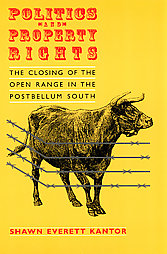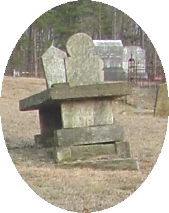
Wahoo Baptist Church cemetery
Wahoo, Georgia
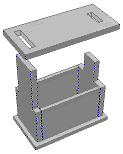
|
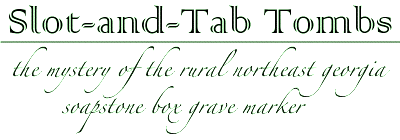
: an empty decorative stone grave shelter in the shape of a box with an oblong horizontal lid (ledger stone) of local soapstone (local greenish-grey soft chloritic schist) with two slots cut into it, through which the vertical head and foot stones are fitted, called a 'through mortise-and-tenon joint' in woodworking. The ledger stone is thus suspended over an internal empty cavity by the weight-bearing shoulders of the head- and footstones, and by either (a) long cut stone blocks (squared-stone-logs) approximately 5"x5"x(~length of body), stacked one on top of the other equally on each side, or by (b) one-piece side slabs, to create an above-ground stone box monument that resembles a tomb. The body is presumably underground since no remains have been seen inside exposed internal cavities of broken or collapsed boxes.
purposes: an ornate hole covering; a stone grave shelter; a decorative means of preventing wandering open-range livestock from stepping into the softer dug earth of a human grave; also used to prevent predators & scavengers, including human 'resurrectionists', from digging up a buried human body, especially in shallow graves dug into rocky ground;
similar in purpose to the wolf (ledger) stone.
168 found to date in ±24 Upland South folk cemeteries
almost exclusively in rural northeast Georgia around Wahoo.
ethnicity: English & Scotch-Irish and predominantly Baptist.
dates: 1848-1889, the latter corresponding with the closing of the state's open range and fencing of livestock in pastures. locally quarried & carved.
original research by tpkunesh © 2000-2011
|
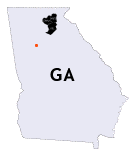
|
" Many [Lumpkin County] graves are marked with Soapstone markers
carved to fit with precision of a carpenter with wood. " - DP
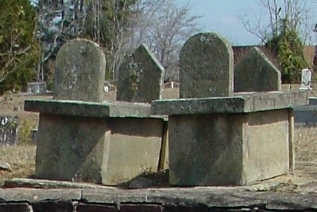
Mount Hope public cemetery
Dahlonega, Georgia |
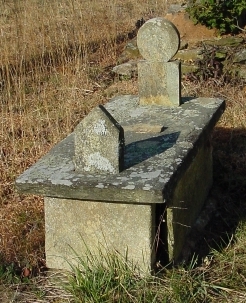
O'Kelley family cemetery
south of Shoal Creek Baptist Church
|
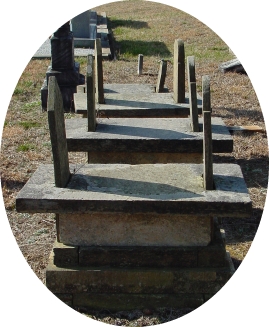
Shoal Creek Baptist Church cemetery
west of Cleveland GA
|
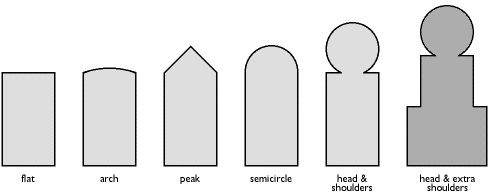
types of headstones
The double-shouldered headstone is found as a remnant of the slot&tab tomb.
The extra shoulders are used to support the slotted ledger stone.
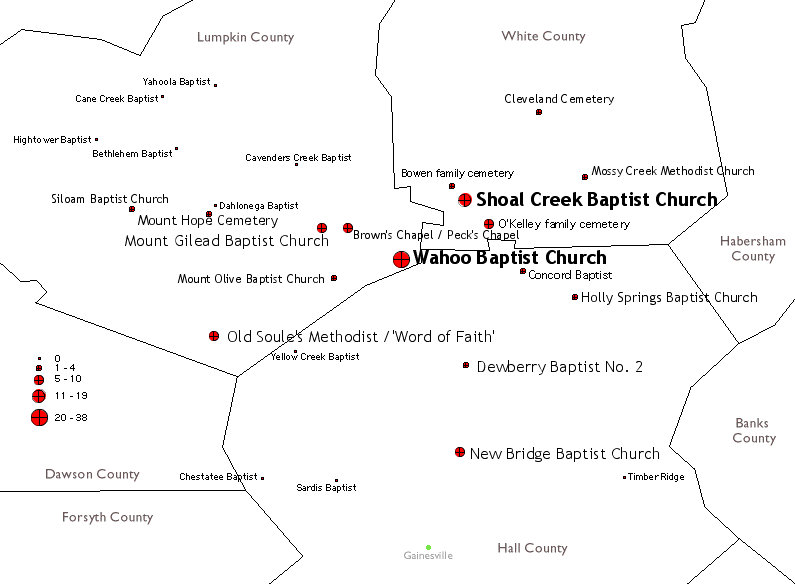 |
|
all sites are within an 11-mile radius from Wahoo Baptist Church
|
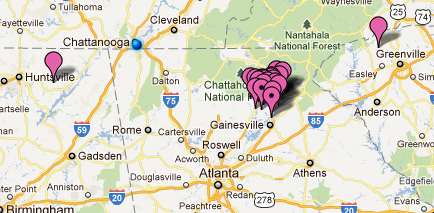 |
|
maps by google |
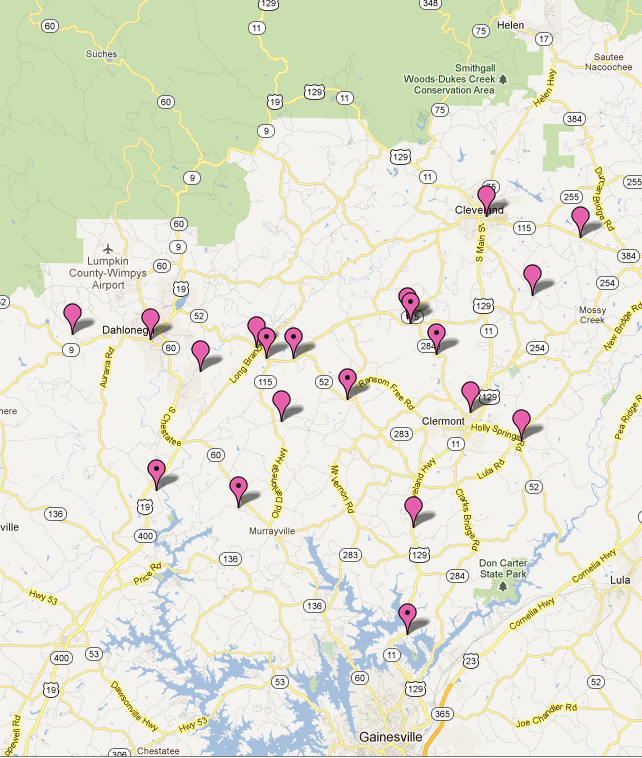 |
other interesting SouthEast USA burial monuments
|
|
Tennessee
- Concord Baptist Church, Chattanooga, Hamilton County
- wooden gravemarker/headboard, Chattanooga, Hamilton Co.
- Montgomery cemetery Hamilton Co. - table tombs
- Hixson family cemetery, Chattanooga, Hamilton Co.
- Hixson family cemetery, near Dunlap, Bledsoe County
- Greenwood Columbia, Maury County - table tombs
- Zion Church Mt. Pleasant, Maury Co.
- the Cumberland Bledsoe, Van Buren & Overton Counties - tent tombs
fun reading: Low-Cost Large Scale Aerial Photography &
the Upland South Folk Cemetery, by Eric B. Wolf,
Northwest Missouri State University 2006
|
a world away: slot & tab tombs in the Middle East (Israel/Palestine, Egypt, Turkey)
|
similar - the larger wooden grave shelter
- "OBSERVATIONS ON THE FORM AND FUNCTION OF MIDDLE TENNESSEE GRAVEHOUSES", Donald B. Ball, Tennessee Anthropologist, Tennessee Anthropological Association II(1):29-62. 1977. An intensive survey of three contiguous Middle Tennessee counties (Cannon, Coffee, and Rutherford) has documented a total of 16 extant gravehouses in nine cemeteries plus to former location of several others. Built to cover an in-ground interment, these structures were found to exhibit a high degree of diachronic attribute similarity when recorded in detail and compared architecturally to one another. It is suggested that these structures represent a traditionally patterned mechanism for the tangible expression of sentiment on a personal, rather than social, basis. To place these little studied structures in a spatial and historical framework, data are presented pertinent to both their distribution in North America and probable European source area.
|
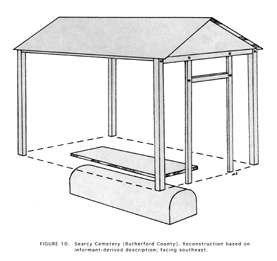 |
|
photos of three grave houses in NE Georgia: |
child's low gravehouse ca. 1968
child's bavarian-style gravehouse ca. 1978. photos 11-14
group gravehouse
|
|
|
|
|

|
The tabletop tomb was a fad during the mid-19th century. "The people are buried in the ground, underneath the box tomb," Ruedrich said. "Yet half the box tombs I've worked on have had their tops taken off by curiosity-seekers looking for a body. So the more people who understand that no one is buried in there, the better off we'll be." - Dean Ruedrich,
historic preservationist, Ruedrich Restorations of Bunn NC. |
& btw, what does S.T.K.S.H.T.W.S. mean?
|
Falling Springs Baptist Church cemetery ->
Allred, Overton County, Tennessee

other sites w/photos
1
2
3
4
5
6
|
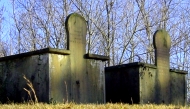

|
- aniconism
- in religion, opposition to the use of icons or visual images to depict living creatures or religious figures. Such opposition is particularly relevant to the Jewish, Islamic, and Byzantine artistic traditions, eg, iconoclasm. The biblical Second Commandment (part of the First Commandment to Roman Catholics and Lutherans), "You shall not make yourself a graven image, or any likeness ... - Encyclopædia Britannica
- cenotaph
- literally "empty tomb", from the Greek kenotaphion, from kenos empty + taphos tomb.
A symbolic tomb, honoring the dead but not containing the body; often a tomb or a monument erected to commemorate a person or persons whose remains are elsewhere, such as soldiers buried abroad or sailors lost at sea.
- chest tomb aka cadaver tomb, tomb chest
- tomb designed in the form of a cist or stone box placed over a burial. Its outward form often reproduces the features of the classical sarcophagus or medieval effigy base. - Structural Images of the North East Project, England
- ledger stone
- large (typically 3ft x 6ft) flat (horizontal) stone that covers the top of a gravesite, flush with the terrain or floor; inscribed floor slabs
One of the main challenges has been in repairing the monuments, many of which are brick lined graves with ledger stones on top and a monument on top of the ledger. The design of the graves was to facilitate the removal of a ledger stone so that additional family members could be placed in the grave (some graves contain up to eight people). - on Nunhead Cemetery
- mausoleum
- (Middle English, from Latin, from Greek mausOleion, from MausOlos Mausolus died ab 353 B.C., ruler of Caria; 15th century)
1 : a large tomb; especially : a usually stone building with places for entombment of the dead above ground
- mortise
- a hole, groove, or slot into or through which some other part of an arrangement of parts fits or passes; especially : a cavity cut into a piece of material (as timber) to receive a tenon: a projecting member in a piece of wood or other material for insertion into a mortise to make a joint
- plinth
- a block serving as a base for a statue or gravestone; the lowest member of a base; subbase
- sarcophagus
- (Latin sarcophagus (lapis) limestone used for coffins, from Greek (lithos) sarkophagos, literally, flesh-eating stone, from sark- sarc- + phagein to eat; 1619)
: a stone coffin; broadly : COFFIN
- sepulchre
- or sepulcher (Middle English sepulcre, from Old French, from Latin sepulcrum, sepulchrum, from sepelire to bury; akin to Greek hepein to care for, Sanskrit saparyati he honors; 13th century)
1 : a place of burial : TOMB
- tomb
- (Middle English tombe, from Anglo-French tumbe, from Late Latin tumba sepulchral mound, from Greek tymbos; perhaps akin to Latin tumEre to be swollen; 13th century)
1 a : an excavation in which a corpse is buried : GRAVE b : a place of interment
2 : a house, chamber, or vault for the dead
3 : a building or structure resembling a tomb (as in appearance)
- tympanum / crown
- the top portion of a gravestone (or doorway) above the uppermost horizontal line. Traditional English and New England headstones had semicircular tympanums and footstones triangular typmpanums.
|
b o o k
recommendations
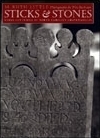
M. Ruth Little,
Sticks and Stones:
Three Centuries of
North Carolina Gravemarkers
1998 University of
North Carolina
Press, Chapel Hill
"best book i've read on the subject" - tpk
types of --->
gravemarkers
figure 1.2
|
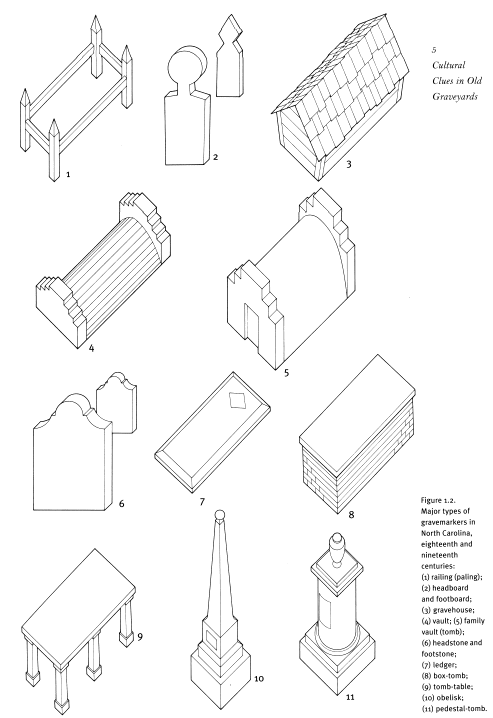
|
types of
headstone shapes
figure 1.10
1 Baroque (eighteenth to early nineteenth centuries);
2 Neoclassiscal Revival (nineteenth to early twentieth centuries).
|
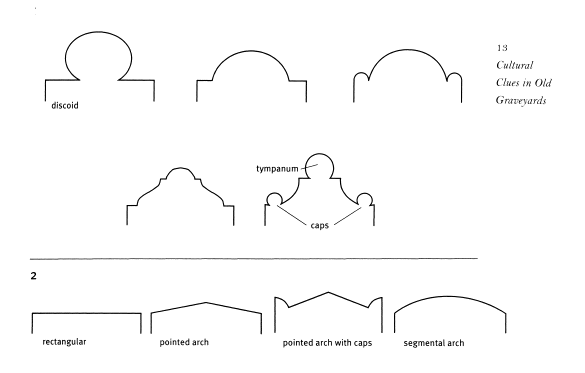
|
articles related to cemetery studies in Tennessee ...











![]()


![]()







